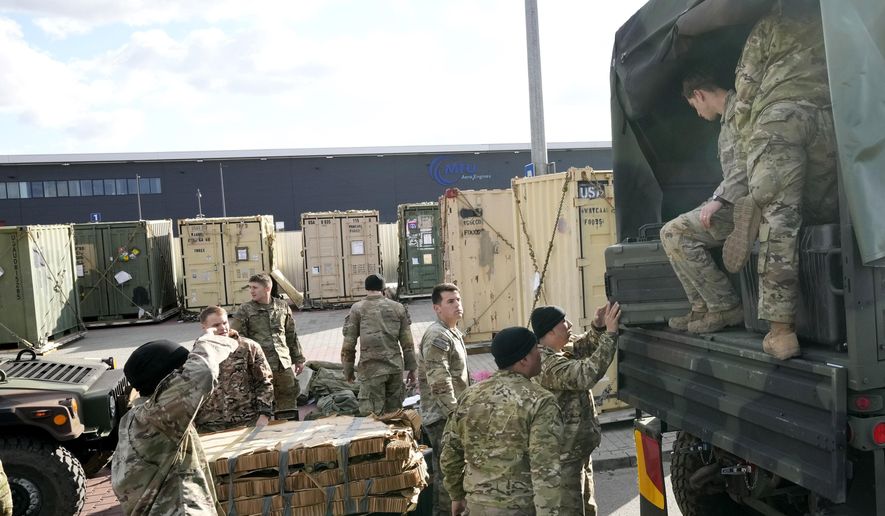RZESZOW, Poland — The small coffee shops, bars and cafes that line the central square in Rzeszow, Poland, still bustle with foreign tourists and students from the local university.
In many ways, it seems almost unimaginable that a war is raging just a brief train ride away in neighboring Ukraine. But locals say there are subtle clues of the dangerous precipice where Europe now stands.
“Military planes are flying above our houses all the time,” said Gabriela Kallaus, 21, a student from Rzeszow. “Like, 24/7.”
In the long lead-up to Russia’s invasion last week, NATO countries have moved forces to defend the alliance’s eastern flank.
For the first time in history, the alliance began mobilizing troops as part of the NATO Response Force. About 500 arrived in Romania to lead the unit, which could swell to 40,000 troops from member countries.
Last month, the U.S. military more than doubled its footprint in Poland by deploying close to 5,000 troops.
SEE ALSO: Russia advances in Ukraine’s south as U.S. widens sanctions net
North of Rzeszow’s city center, U.S. troops have commandeered the G2A Arena across from the Rzeszow-Jasionka Airport. Just weeks ago, the glass-domed exhibition center hosted concerts and trade shows.
Close to 5,000 U.S. troops, most from the Army’s 82nd Airborne Division, have arrived in Poland in recent weeks to assist with humanitarian efforts and bolster NATO’s presence in the farthest reaches of the alliance. Poland has taken the bulk of what the United Nations says are more than 1 million people fleeing the fighting in neighboring Ukraine.
The U.S. has deployed F-15 fighters to Lask Air Base in Poland. Gen. Jeff Harrigian, head of Allied Air Command, said the planes will “elevate the collective defense capabilities on NATO’s eastern flank and the enhanced Air Policing measures.”
A man living near the civilian airport said huge military aircraft were landing every hour with additional troops. Residents closer to the Ukrainian border say the buzz of military helicopters and the drone of military planes overhead wake them up at night.
The additional troops provide a sense of comfort to some. Anea, a 22-year-old law student who didn’t want to provide her last name, said she fears Poland will be the next country in Russian President Vladimir Putin’s sights if Ukraine falls.
“When the war first broke out in Ukraine, I was shocked,” she said. “I couldn’t believe it. I cried almost all day the first day because I thought that Ukraine would fall and in just a few days we’d be gone — we would be a part of Russia.”
SEE ALSO: Stoltenberg nixes NATO ‘no-fly zone’ for Ukraine
She said she feels safer with the additional troops nearby.
Pitching in
Kamil Szymanski, the CEO of G2A Arena, said his company is happy to do its part and will “work tirelessly to support the 82nd Airborne Division.”
“We are proud that during this challenging time, we can strengthen the Polish-American alliance during their operations in Poland,” Mr. Szymanski said in a statement to The Washington Times.
There is a fine line, however, between a NATO show of force to deter further aggression and a provocation that could spiral out of control.
Mr. Putin has cited NATO’s eastward expansion since the end of the Cold War as one of his top grievances. He has demanded that the Western military alliance forever rule out Ukrainian membership in the alliance. Both NATO and Kyiv have rejected the demand.
While supporting Ukraine through sanctions and military aid, surrounding countries have been careful to avoid poking the bear. Polish President Andrzej Duda quickly denied rumors this week that his country would be sending fighter jets to Ukraine. Such a move would draw NATO and Russian forces into direct combat in Ukraine.
“We are not sending any jets to Ukraine because that would open a military interference in the Ukrainian conflict,” Mr. Duda said from Lask Air Base alongside NATO Secretary-General Jens Stoltenberg. “We are not joining that conflict. NATO is not a party to that conflict.”
Mr. Stoltenberg said the alliance is supplying Ukraine with military and humanitarian support, but “NATO is not to be part of the conflict.”
The risk of escalation is not lost on Poles, who have a long and tangled history of conflict with Russia.
Pawel Dorobek, 22, said most in Poland are not burdened with a constant fear of war, but the thought of donating fighters to Ukraine made him anxious.
“It was scary for me because Russia would see that as a threat from a NATO country,” he said.
Przemyslaw Szymanski, a 25-year-old law school student, said life carries on, but all in Rzeszow and Poland are aware of the dangerous period Europe has suddenly entered.
“The troops at the airport are really close,” he said. “I think the war is much closer now than it was.”
• Joseph Clark can be reached at jclark@washingtontimes.com.




Please read our comment policy before commenting.